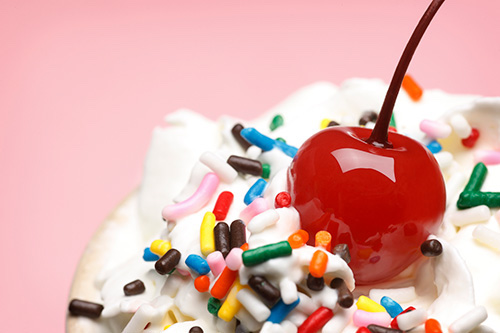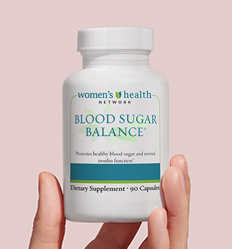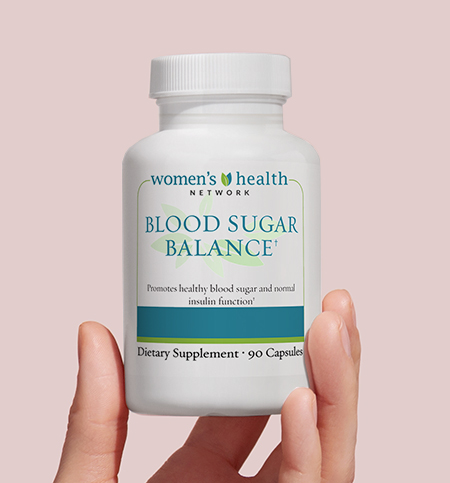Authored by Dr. Sarika Arora, MD
About four years ago, I noticed I was getting moody right before my periods. I’d always considered myself healthy, but knew there were things I could do to improve. As a functional medical doctor, I also knew that nutrition most likely had a lot to do with my mood swings. So I decided to clean up my diet, especially when it came to sugar and refined carbohydrates like pasta, white rice, white potatoes and bread.

Sugar and refined carbohydrates are best known for their effects on weight gain, but these foods are frequently at the root of your worst PMS and menopause symptoms, too, especially when it comes to fatigue, cravings and mood swings. From my own experience and from the women I see daily in my practice, this one step can make a tremendous difference. When I cut sugar (and when I refer to “sugar” I mean all refined carbs, not just the white powdery stuff), my irritability vanished. Similarly, patients and friends of mine who have stopped eating sugar feel more energy, little to no cravings or cramps, fewer hot flashes and much more!
Sugar’s effect on your hormones
Sugar not only provides major highs and lows in mood and energy, it can also disrupt one of the most powerful hormones in the body: insulin. And insulin is closely connected to all of the other hormones in your body, including estrogen and testosterone.
Sugar increases estrogen — and that’s not helpful
Did you know women with PMS eat 275% more refined sugar than those without PMS? This can pump up estrogen levels, and that’s not a good thing. Excess estrogen throws other hormones into imbalance, which only worsens symptoms.
Fat cells produce estrogens
Fat cells, especially those found in visceral midsection belly fat, produce estrogen. When you eat excess amounts of sugar, the body copes with it by turning it into fat cells, which then produce estrogen. The more sugar you eat, the more fat cells you create and the more estrogen you produce.
Insulin spikes trigger hormonal imbalance “perfect storm”
Eating excess sugar also leads to insulin spikes as the body secretes the hormone to help cells accept blood sugar for energy. Elevated insulin can lead to lower levels of an important protein known as sex hormone binding globulin (SHBG). SHBG binds excess estrogen and testosterone in the blood, but when it’s low, these hormone levels increase.
These effects mean the ratio of estrogen to progesterone (known for keeping us calm and happy) is way too high, leading to irritability, anxiety, insomnia and more. And as women reach menopause, symptoms get more intense and can include hot flashes and night sweats as well.
Sugar increases female testosterone
Insulin also increases the production of testosterone. For women, testosterone plays an important role in regulating sexual function, bone density and muscle mass. However, excess testosterone can lead to unwanted symptoms like acne, hair loss and mood swings.
But there’s even more to the story. When testosterone is produced, it’s then converted into estrogen by fat tissue in the belly, adding to the hormonal roller coaster.
Effect of excess sugar on women’s health
Excess sugar consumption can have negative effects on women’s health, including increased risk of insulin resistance and type 2 diabetes. Sugar triggers chronic inflammation, which in turn contributes to high blood pressure, heart disease and non-alcoholic fatty liver disease. Excessive sugar intake, particularly through sugary drinks, deceives the body into shutting off its appetite-control system since liquid calories are less filling than those from solid foods. As a result, individuals tend to consume more calories overall, heightening the risk for obesity.
Instead of NO sugar, think glycemic control
Cutting all sugar out of your life is next to impossible. Fruit, vegetables and even legumes have some sugars in them. The trick is to lower your glycemic load. Glycemic load is an estimate of how much the carbohydrates in a certain food or meal will raise a person’s blood sugar after eating it. You want to gradually increase blood sugar and insulin as opposed to causing spikes and dramatic drops.
Simple, refined sugars cause spikes in blood sugar and insulin. But complex carbohydrates, fiber, protein and healthy fats promote more gradual increases and decreases in blood sugar and insulin, lowering the glycemic load and lifting the burden on your hormones.
I have a patient who used to keep a bag of hard candy in her purse. Whenever she was nervous or bored she’d unwrap a piece of candy and eat it. It was difficult for her to stop this long-time habit, but she now keeps a bag of nuts in her purse instead. She rotates between walnuts, pistachios and pecans to keep her taste buds interested. This small change not only helped with cravings, mood swings and fatigue, but her blood sugar went from 98 to 93 — a significant improvement!
Tricks to lower your glycemic load
- Switch from white rice to brown or wild
- Replace sweet potatoes for white
- Try mashed avocado instead of dipping chips in salsa
- Add an extra serving of veggies to your plate instead of the carb choice
- Drink mineral water with a lime or lemon instead of soda
- Add nuts, nut butter or gluten-free oats to your favorite cookie recipe
4 ways to balance your hormones and curb the sugar habit
There are multiple ways to balance your hormones and ease symptoms of PMS and menopause. Here are some approaches I use in my practice:
1. Natural hormonal support.
Chromium picolinate is an excellent option for supporting insulin regulation and blood sugar. And for those uneven estrogen to progesterone ratios you might try lemon balm, passionflower, chasteberry, wild yam and maca. We’ve made it easy by combining these powerful herbs (plus more!) in our Herbal Equilibrium for menopause symptoms.
2. Sugar-busting nutrients.
To curb sugar cravings be sure your multivitamin includes zinc, Vitamin C and B-vitamins. It’s also important to take an omega-3 supplement. The omega-3s in fish oil can not only help with cravings and inflammation, but also improve insulin sensitivity.
3. Mix protein, fiber and healthy fat with treats.
Take a look at the chart above for ideas. Also, be sure to include lots of cruciferous vegetables in your diet, like Brussels sprouts, broccoli, cabbage and kale for added hormone balancing.
4. Lower your stress burden.
This step counts as a double whammy because high levels of the stress hormone cortisol can disrupt blood sugar, increase cravings and disrupt estrogen and progesterone balance. I use Dr. Andrew Weil’s 4-7-8 (or Relaxing Breath) exercise with my patients. Dr. Weil calls it a “natural tranquilizer.” Here’s what to do:
- Exhale completely making a whoosh sound through your mouth
- Inhale through your nose to a count of 4
- Hold the breath in your lungs for a count of 7
- Release the breath in a whoosh from your mouth to a count of 8 breathing out all the stress in your body
I have my patients do this exercise upon waking in the morning for ten rounds, ten rounds at lunch and then ten rounds again before bed. There are lots of choices for decreasing stress, but this is a great first step for busy women.
Feel and look your best — starting today!
Even if you aren’t worried about your waistline, cutting back on or eliminating sugar helps rebalance your hormones, and can dramatically ease your symptoms. We offer herbal and nutrient support, as well as hormone-balancing diets and recipes, lifestyle tips and free phone support whenever you need help. I’m the first to admit that sugar tastes good, but my advice is to eat it on special occasions instead of everyday. You’ll not only lose weight, you’ll minimize symptoms and support your health on every level!











